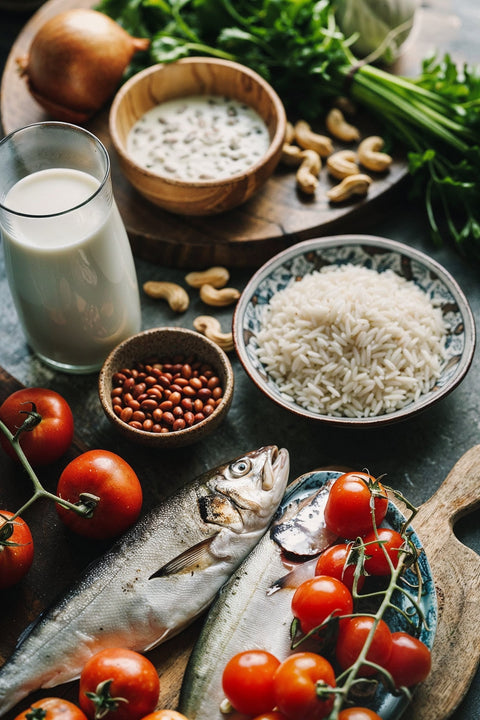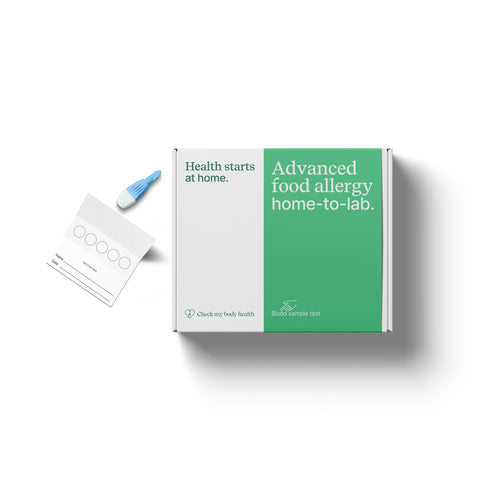The Food Intolerance Index
What is a food intolerance?
A food intolerance occurs when your body struggles to digest or metabolise certain types of food or drink. This can cause a range of symptoms such as flushing skin, headaches or fatigue. However, most food intolerance symptoms are experienced around the stomach and gut, including bloating, cramps, nausea, diarrhoea and constipation.
If you have an intolerance, you’ll likely experience these symptoms every time you eat a specific type of food or food that contains a certain ingredient. They can be difficult to manage and the symptoms can range from mild to severe. Not only can the symptoms be painful and uncomfortable, but also potentially embarrassing.
A food intolerance isn’t the same as an allergy, however, a lot of the symptoms can be the same so there is some crossover that means they can be difficult to tell apart. The main difference is that an allergy is caused by your immune system while an intolerance is due to your body’s inability to process a certain type of food.
Thankfully, there are food intolerance tests and food allergy tests that can help you pinpoint exactly what foods and other triggers your body may struggle with.
Common food intolerances
Food intolerances are relatively common, so if you do experience symptoms whenever you eat something specific, it’s possible that it directly causes those symptoms. For example, one in ten people are lactose intolerant, so will feel effects when they drink milk or eat food containing dairy. But there’s a wide range of foods that humans can have an intolerance to, which can make narrowing it down challenging. Some of the most common food intolerances include:
- Dairy, such as milk, yoghurt and cheese
- Gluten, such as bread, cereal and pasta
- Wheat, such as pasta, bread and pastry
- Eggs, including chicken and duck eggs
- Yeast, such as bread, beer and parties
- Sugar, such as sweets, fizzy drinks and processed food.
But these are just some of the foods you may develop an intolerance to. We’ll explore more potential triggers below.
What causes a food intolerance?
After you’ve eaten, your body begins the process of digesting your food and converting it into energy. If you have an intolerance, your body will find it difficult to digest a particular chemical in the food, which is what leads to unpleasant or painful symptoms. For example, if you have a dairy intolerance, your body can’t process the lactose – the sugar found in milk – so it remains in your gut until it’s broken down by bacteria.
Sometimes the intolerance can be caused by your body lacking the specific protein or enzymes it needs to break down these chemicals. It may also be caused by a gastrointestinal disease, though this is far less common.
Can you develop a food intolerance at any time in your life?
Yes, even if you’ve never experienced any kind of discomfort or symptoms after eating before, you can develop a food intolerance or a food allergy at any stage of your life. If your family has a history of intolerances, this can increase the likelihood that you’ll also develop something similar at some point – though it’s not guaranteed. It may also be a different type of intolerance, which makes it difficult to identify.
Fruit intolerances
If you believe you experience the symptoms of an intolerance after eating fruit, you may have a fructose intolerance. Fructose is the sugar that’s found naturally in fruit and is a fairly common food intolerance.
There are two types of fructose intolerance, dietary fructose intolerance (DFI) when your body can’t digest fructose, and hereditary fructose intolerance (HFI), when your body has a build-up of sugar that leads to complications. Thankfully HFI is relatively rare.
If you only experience symptoms after eating certain fruits, such as strawberries and peaches, you may have an intolerance to food in the Rosaceae family or food that contains a protein called bet v1.
Here’s a list of other possible fruit intolerances:
Vegetable intolerances
Similar to fruit, some vegetables also contain high levels of fructose, which means if you have a fructose intolerance you may experience symptoms after eating certain veggies. This includes broccoli, artichokes, mushrooms, peas, red pepper and tomato.
Other vegetable intolerances include:
Another possibility is food in the allium family. If you have an allium intolerance, your body will struggle to digest onions and other similar foods, like garlic, leeks, shallots, Shiitake mushrooms and chives.
Meat intolerances
Meat intolerances are relatively rare, but over the past 15 years, the number of people confirmed to have red meat sensitivity in the US has grown by more than 141,566%. And this figure is expected to rise further as science uncovers more about allergies and intolerances to meat. If you have a sensitivity to red meat then you may experience symptoms after eating beef, pork, lamb or venison or food that contains red meat, like stews, pasta or barbecue food.
Poultry such as chicken and turkey can also be the cause of an intolerance.
Fish & seafood intolerances
Fish, seafood and seaweed allergies can often be severe, but it’s also possible to have a fish intolerance. This is usually caused by parvalbumin, a protein found within the meat and is found in almost every type of fish we tend to eat, including salmon, tuna and cod.
Dairy intolerances
Dairy intolerance is the most common food intolerance in the world, with around 25% of people struggling to digest the sugars found in milk. That means, if you have a lactose intolerance, you’ll likely experience symptoms when you eat or drink:
- Milk
- Butter
- Cream
- Chocolate
- Certain cheeses
- Milkshakes
- Ice cream
- Yoghurt
Cheese
If you’re lactose intolerant, you may still be able to eat certain types of cheese that are low in lactose. This includes hard cheeses like parmesan, cottage cheese and cheddar. However, everyone’s different so this might not be the case for you.
Egg intolerance
Eggs are a versatile food that can be eaten in a variety of different ways on its own, but also as an ingredient in cakes, pastries, desserts, processed meat, pasta, condiments and more. If you have an egg intolerance, you may have an intolerance to the white, the yolk or both.
Gluten intolerances
Gluten is a protein found in different cereals and grains which means it’s found in a huge range of different foods, including pasta, bread, cereal, cake, soup and beer. Gluten intolerance is relatively common in the UK, so if you experience symptoms when eating different types of food that contain cereals and grains then that could be the cause. If you do suffer from a gluten intolerance, you may want to consider natural gluten-free options such as rice.
Wheat intolerances
It’s possible to have a wheat intolerance while not also having a gluten intolerance. Someone with a gluten intolerance struggles to digest the protein gluten, while someone with a wheat intolerance only struggles to digest wheat. However, wheat is a key ingredient in pasta, cakes and processed foods, so there is some crossover. For more information read our article on the difference between wheat and gluten intolerances.
Yeast intolerances
Yeast is an ingredient commonly used in food including bread, cakes, beer and pastries, which means it can also be confused with a gluten intolerance. And because yeast is a fungus it can become airborne very easily, meaning it’s possible to inhale spores which can cause symptoms. That means a yeast intolerance or allergy can be tricky to manage.
Nut intolerances
Tree nuts are another common intolerance and allergy trigger that has symptoms ranging from mild to severe. Walnuts, cashew nuts, hazelnuts, pecans, pistachios, macadamia nuts and brazil nuts are all types of tree nuts. They’re found in lots of different foods, including chocolate, cereal, desserts and sauces.
Other food intolerances
The above intolerances are some of the most obvious, but there are lots of other food and drinks you might consume that have less obvious ingredients in them that your body struggles to process. It could be a specific ingredient, such as wheat, or a chemical, like a preservative.
Other food intolerances we often see include:
Drinks
While you can’t specifically have an intolerance to drinks, you may have an intolerance to one of the ingredients in your favourite drinks which will still lead to you experiencing symptoms. For example, you may have a caffeine intolerance, which means you may have symptoms when you drink fizzy drinks or coffee. Sulphites and yeast are found in beers and other alcoholic drinks. You may also have an alcohol intolerance which produces symptoms whenever you drink anything containing alcohol.
Oils and condiments
Many oils and condiments can also contain ingredients that are potential triggers of intolerance symptoms. If you have a soya intolerance, you may struggle to eat vegetable oil, Rapeseed oil, Worcester sauce and soy sauce. Certain oils may contain triggers such as nuts and coconut oil. And condiments can contain eggs and dairy, two of the most common intolerances.
Additives
One potential cause of an intolerance that is very much hidden away on food labels is additives. There are also many different types of additives, which makes it tricky for you to narrow down a specific trigger. These could be:
- Artificial colours
- Preservatives
- Thickeners
- Emulsifiers
- Flavour enhancers
- Stabilisers
- pH control agents
Non-food intolerances
You may also experience symptoms when you come into contact with various non-foods, which can also be a sign of sensitivity. These include:
- Mould
- Latex
- Animals
- Medicines
- Insect stings or bites
- Hair dye
- Chlorhexidine
Metal sensitivities
You can also suffer from a metal sensitivity, which means you may experience symptoms when you come into contact with certain metals, such as copper, cobalt or nickel.
Vitamins and minerals
While it’s exceptionally rare to have an intolerance or allergy to specific vitamins or minerals, it’s also rare but possible that you may experience symptoms after taking multivitamins, which is often caused by the excessive amount of specific vitamins and minerals in supplements. If you do have symptoms after taking vitamin and mineral supplements it’s recommended that you stop until you pinpoint the cause.
How to test for a food intolerance
Living with a food intolerance can be tricky, but it can be very challenging if you don’t know what foods cause you to experience nasty symptoms. A food intolerance test is a fast and reliable way to find out your body’s complex relationship with food so you can make positive changes and take back control of your health.
Complementary Alternative Medicine (CAMS)
Our food sensitivity tests are carried out using bioresonance therapy and is categorised under Complementary and Alternative Medicines (CAMs) which covers a wide range of therapies that fall outside mainstream medicine. Tests and related information provided do not make a medical diagnosis nor is it intended to be a substitute for professional medical advice, diagnosis or treatment.
Always seek the advice of your doctor or other qualified health provider if you have a medical condition or with any questions you may have regarding a medical condition and/or medical symptoms.
























